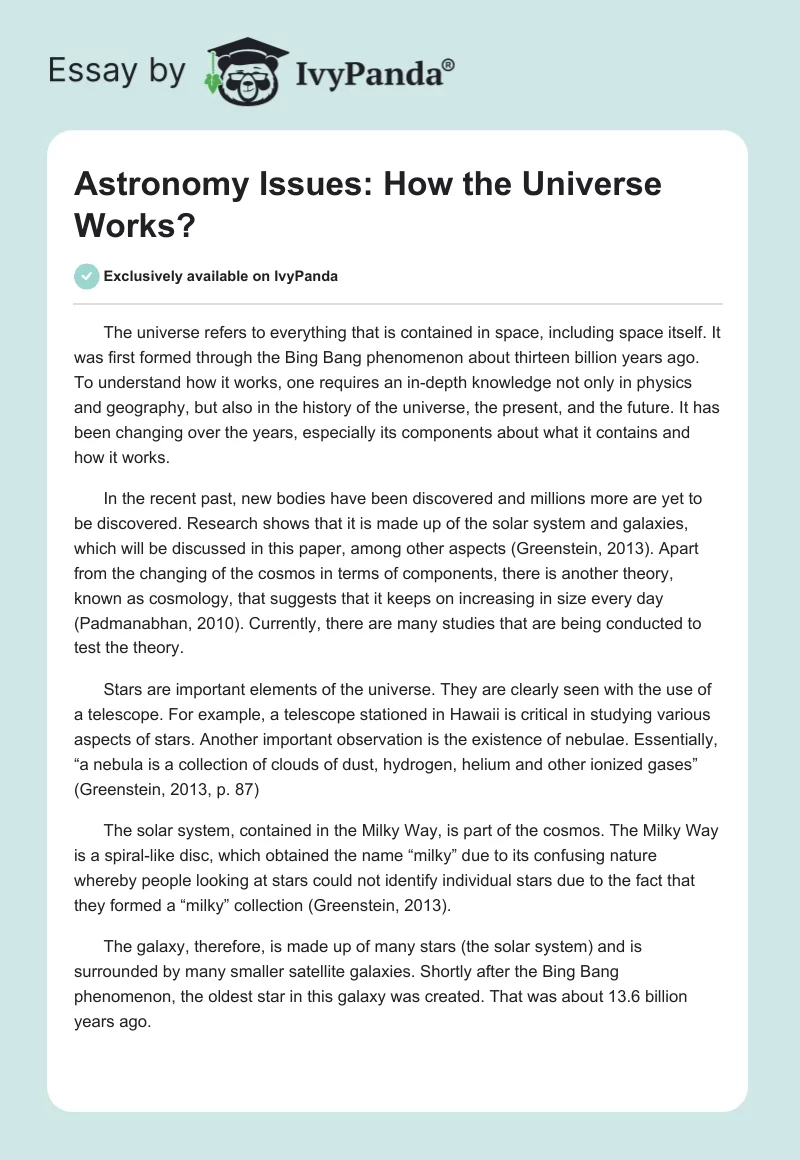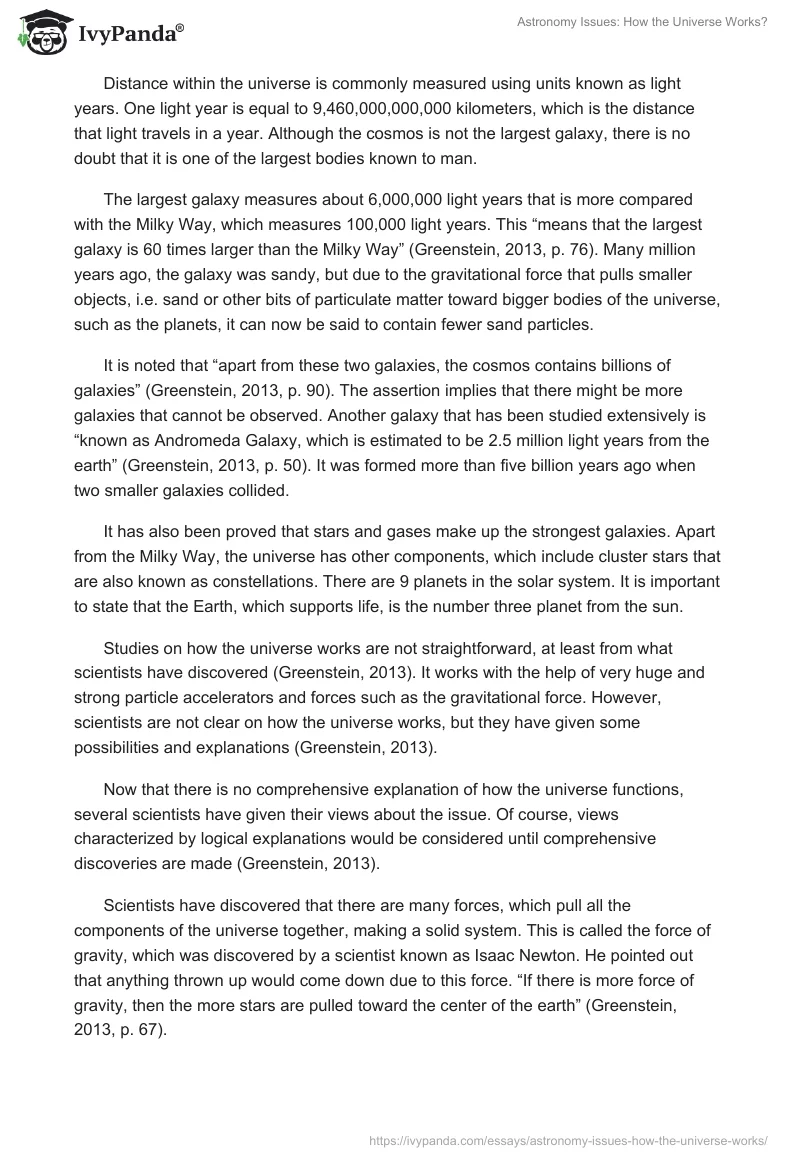The universe refers to everything that is contained in space, including space itself. It was first formed through the Bing Bang phenomenon about thirteen billion years ago. To understand how it works, one requires an in-depth knowledge not only in physics and geography, but also in the history of the universe, the present, and the future. It has been changing over the years, especially its components about what it contains and how it works.
In the recent past, new bodies have been discovered and millions more are yet to be discovered. Research shows that it is made up of the solar system and galaxies, which will be discussed in this paper, among other aspects (Greenstein, 2013). Apart from the changing of the cosmos in terms of components, there is another theory, known as cosmology, that suggests that it keeps on increasing in size every day (Padmanabhan, 2010). Currently, there are many studies that are being conducted to test the theory.
Stars are important elements of the universe. They are clearly seen with the use of a telescope. For example, a telescope stationed in Hawaii is critical in studying various aspects of stars. Another important observation is the existence of nebulae. Essentially, “a nebula is a collection of clouds of dust, hydrogen, helium and other ionized gases” (Greenstein, 2013, p. 87)
The solar system, contained in the Milky Way, is part of the cosmos. The Milky Way is a spiral-like disc, which obtained the name “milky” due to its confusing nature whereby people looking at stars could not identify individual stars due to the fact that they formed a “milky” collection (Greenstein, 2013).
The galaxy, therefore, is made up of many stars (the solar system) and is surrounded by many smaller satellite galaxies. Shortly after the Bing Bang phenomenon, the oldest star in this galaxy was created. That was about 13.6 billion years ago.
Distance within the universe is commonly measured using units known as light years. One light year is equal to 9,460,000,000,000 kilometers, which is the distance that light travels in a year. Although the cosmos is not the largest galaxy, there is no doubt that it is one of the largest bodies known to man.
The largest galaxy measures about 6,000,000 light years that is more compared with the Milky Way, which measures 100,000 light years. This “means that the largest galaxy is 60 times larger than the Milky Way” (Greenstein, 2013, p. 76). Many million years ago, the galaxy was sandy, but due to the gravitational force that pulls smaller objects, i.e. sand or other bits of particulate matter toward bigger bodies of the universe, such as the planets, it can now be said to contain fewer sand particles.
It is noted that “apart from these two galaxies, the cosmos contains billions of galaxies” (Greenstein, 2013, p. 90). The assertion implies that there might be more galaxies that cannot be observed. Another galaxy that has been studied extensively is “known as Andromeda Galaxy, which is estimated to be 2.5 million light years from the earth” (Greenstein, 2013, p. 50). It was formed more than five billion years ago when two smaller galaxies collided.
It has also been proved that stars and gases make up the strongest galaxies. Apart from the Milky Way, the universe has other components, which include cluster stars that are also known as constellations. There are 9 planets in the solar system. It is important to state that the Earth, which supports life, is the number three planet from the sun.
Studies on how the universe works are not straightforward, at least from what scientists have discovered (Greenstein, 2013). It works with the help of very huge and strong particle accelerators and forces such as the gravitational force. However, scientists are not clear on how the universe works, but they have given some possibilities and explanations (Greenstein, 2013).
Now that there is no comprehensive explanation of how the universe functions, several scientists have given their views about the issue. Of course, views characterized by logical explanations would be considered until comprehensive discoveries are made (Greenstein, 2013).
Scientists have discovered that there are many forces, which pull all the components of the universe together, making a solid system. This is called the force of gravity, which was discovered by a scientist known as Isaac Newton. He pointed out that anything thrown up would come down due to this force. “If there is more force of gravity, then the more stars are pulled toward the center of the earth” (Greenstein, 2013, p. 67).
From this, it has been concluded that gravity pulls stars together. Therefore, their movements are controlled by gravitational force (Padmanabhan, 2010). The gravitational force on the Earth is an important aspect because it helps to keep things on the surface. It has been shown that the force on other planets is very weak. In fact, that is why objects can rarely be maintained on them (Padmanabhan, 2010).
The dark matter that constitutes about 85% of the matter in the whole universe cannot be ignored when discussing the cosmos (Padmanabhan, 2010). The matter has been proposed to account for the gravitational effects that tend to results in an invisible mass known as “dark matter”. Due to its high percentage, the substance is literary everywhere. It neither emits nor absorbs light.
Related to the dark matter is the black hole, which is a space within the universe where the force of gravity does not allow anything to escape, not even light. Due to the fact that the black hole cannot be observed, its existence is associated with the presence of other matter, such as the light. The presence of light signifies the absence of the black hole and the absence of light automatically indicates the presence of the black hole (Greenstein, 2013).
There is a very large distance between the black hole and the Earth. When comparing the black hole with the dark matter, one would conclude that the substance is bigger than the dark spot, which occupies only specific places in the universe. On the other hand, the dark matter consists of approximately 85% of all the matter of the universe (Greenstein, 2013).
Studying the universe is a very interesting topic because it helps learners to understand their “home” and appreciate nature. Analyzing the cosmos is important in knowing why only the Earth among all other plants supports life. It would be essential to evaluate the amounts of components that would be anticipated in the other planets that would be key to support the lives of both human beings and animals.
References
Greenstein, G. (2013). Understanding the Universe. Cambridge, UK: Cambridge University Press.
Padmanabhan, T. (2010). Why does the universe expand?. General Relativity and Gravitation, 42(11), 2743-2750.


